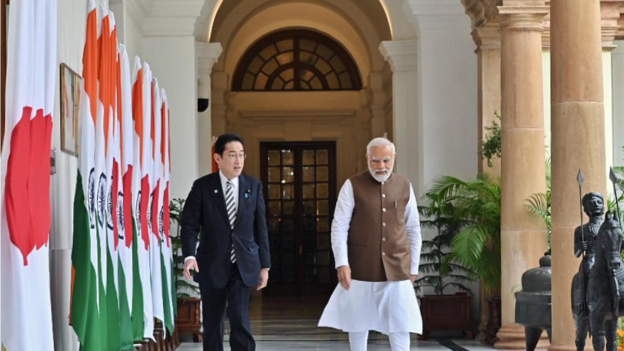Japanese PM Kishida proposes a new plan in India; to focus on security and infra
Japan would mobilize a total of more than $75 billion in public and private funds in the Indo-Pacific region infrastructure and grow together with other countries, says prime minister Kishida.
Japan would mobilize a total of more than $75 billion in public and private funds in the Indo-Pacific region infrastructure and grow together with other countries, says Japanese prime minister Kishida Fumio. The deadline is set for 2030.
Kishida Fumio, who is visiting India, delivered a policy speech entitled “the Future of the Indo-Pacific—Japan’s New Plan for a ‘Free and Open Indo-Pacific’ — ‘Together with India, as an Indispensable Partner’” at the Indian Council of World Affairs (ICWA), announcing Japan’s new plan for a “Free and Open Indo-Pacific (FOIP).”
In his clear term, Kishida stated that at a time when the international community is at a historic turning point, the concept of FOIP is becoming more important than ever toward the goal of leading the international community in the direction of cooperation rather than division and confrontation.
Prime Minister Kishida went on to outline that the fundamental concept of FOIP remains the same even at this turning point. While he emphasized the core principles of FOIP, such as defending freedom and rule of law and respecting diversity, inclusiveness, and openness, he also expressed that Japan would strengthen coordination with other countries and expand the networks among countries that share the vision of FOIP, and direct efforts in the spirit of co-creation.
Four pillars of Indo-Pacific
Prime Minister Kishida set forth the new “four pillars” of cooperation for FOIP: principles for peace and rules for prosperity, addressing challenges in an Indo-Pacific way, multi-layered connectivity, and extending efforts for security and safe use of the “sea” to the “air”.
He explained in concrete terms the expansion of cooperation for FOIP by incorporating realistic and practical cooperation in a wide range of areas, such as climate change, food security, global health and cybersecurity. Kishida also announced a new contribution of $100 million to the Japan-ASEAN Integration Fund.
Prime Minister Kishida stated that in expanding cooperation for FOIP, Japan would engage in the strategic use of official development assistance (ODA), expand our ODA in various forms, and from this viewpoint, revise the Development Cooperation Charter and set forth guidelines for ODA for the next 10 years.
He also announced that Japan would launch an “offer-type” cooperation, introduce a new framework for “private capital mobilization-type” grant aid, and move forward with the amendment of the JBIC Law. He also announced that Japan would mobilize a total of more than $75 billion in public and private funds in the Indo-Pacific region infrastructure and grow together with other countries. The deadline is set for 2030.
Japan is also radically changing its security strategy. The security cooperation is building in the region where India remains the key partner.
Military alliance in the Pacific
In the past week, the key members of the Quad –the Quadrilateral security dialogue–and their partners with Australia, the UK and the US have unveiled details of their plan to create a new fleet of nuclear-powered submarines. The Indo-Pacific region has been witnessing military cooperation towards building a defence capabilities amid growing hostilities with China.
However, AUKUS divided opinion within Australia with former Australian PM Paul Keating calling it the “worst international decision” by a Labor government since conscription in World War I. Ahead of AUKUS, Australian prime minister Anthony Albanese was in India. Albanese called India a top-tier security partner for his country from the decks of aircraft carrier INS Vikrant.
In a significant move, Japan and South Korea agreed in their summit to resume reciprocal visits by their leaders, which had been suspended for 12 years, and bilateral security talks, to help get relations back on track. Simultaneously defence ministers of Japan, Britain and Italy in Tokyo vowed success in developing a next-generation fighter jet by 2035, a plan unveiled late last year. Japan also deployed Ground Self-Defense Force units including missile squads to a remote southern island near the disputed Senkaku Islands and Taiwan.
Last year, Kishida laid out a radical strategy for building the country’s military capabilities. He announced the biggest-ever military budget across all three divisions of the Japan Self-Defence Forces (JSDF).
He put forth his security roadmap that Japan will spend $318 billion on the military over the next five years. Breaking from its historic stance, Japan has embarked on a capability-building roadmap as the country seeks to build up its defence strategy, including the use of pre-emptive strikes.
While Japan is well aligned with India on the strategic front, defence cooperation is limited to high-stake military exercises only.
Japan’s new defence plan presents a great opportunity for the joint development of next-generation military platforms and systems.
https://www.financialexpress.com/defence/japanese-pm-kishida-proposes-a-new-plan-in-india-to-focus-on-security-and-infra-nbsp/3016674/





